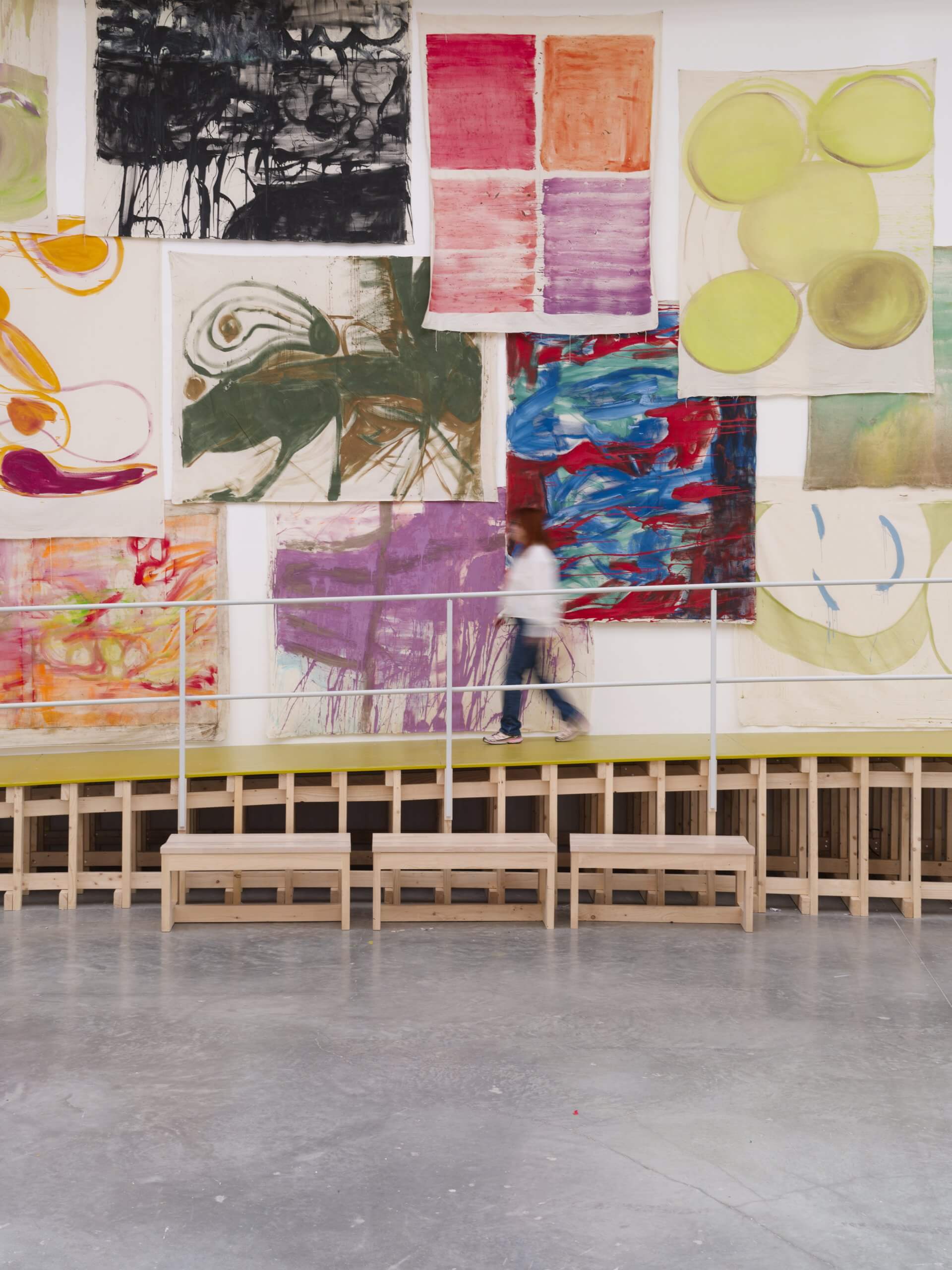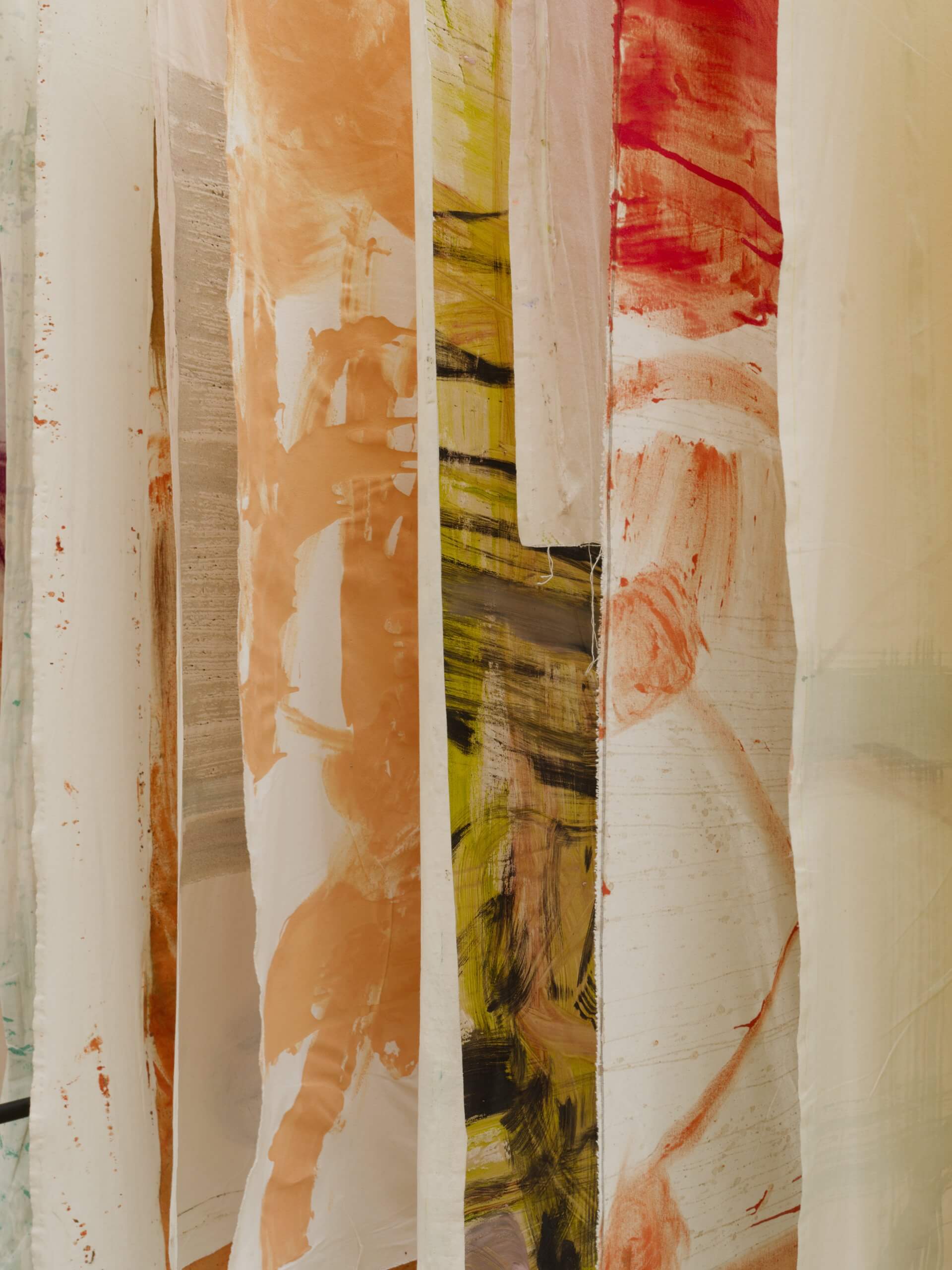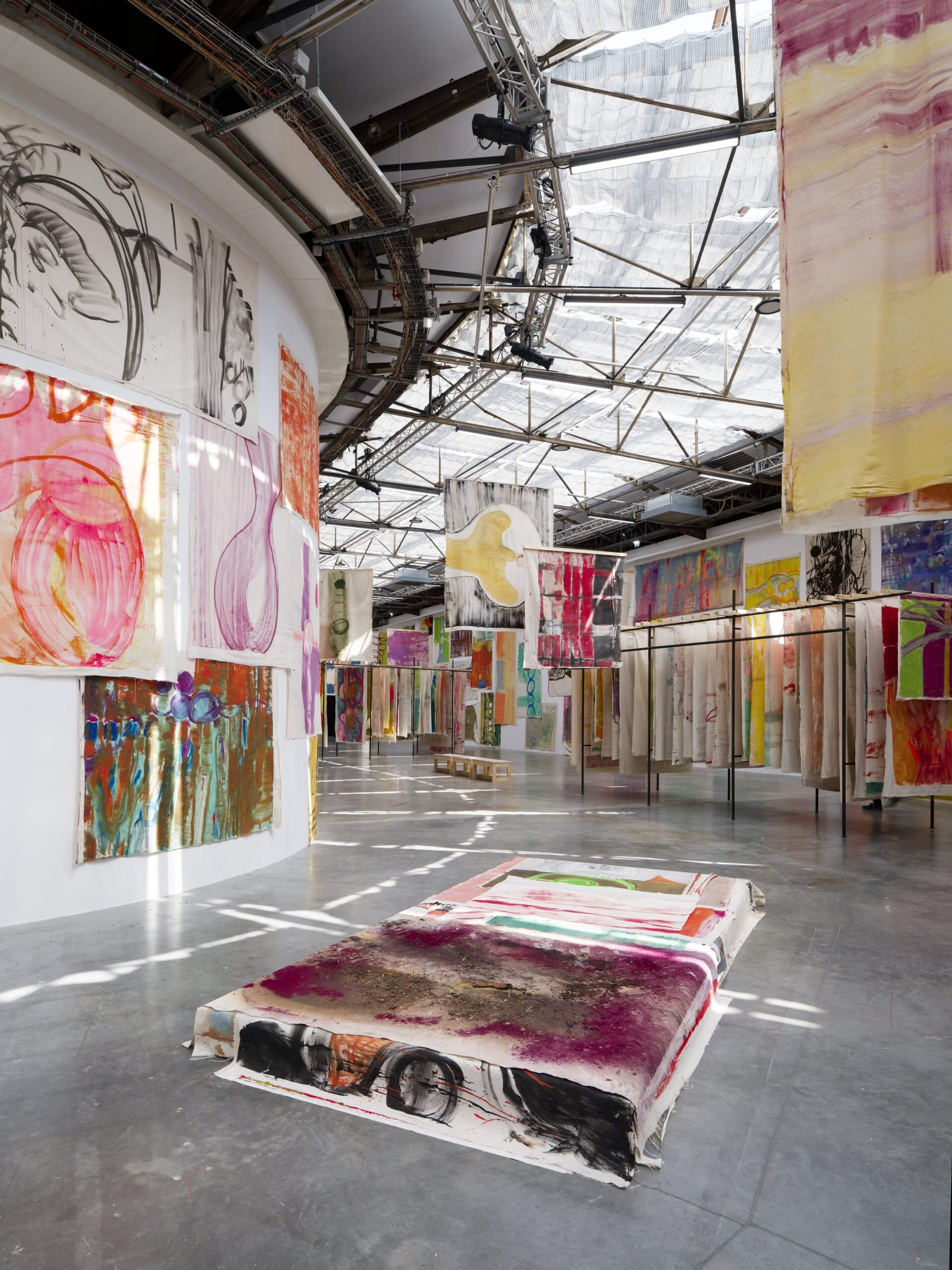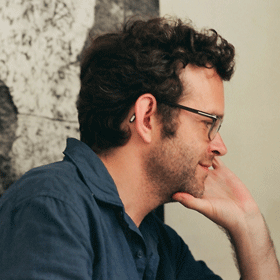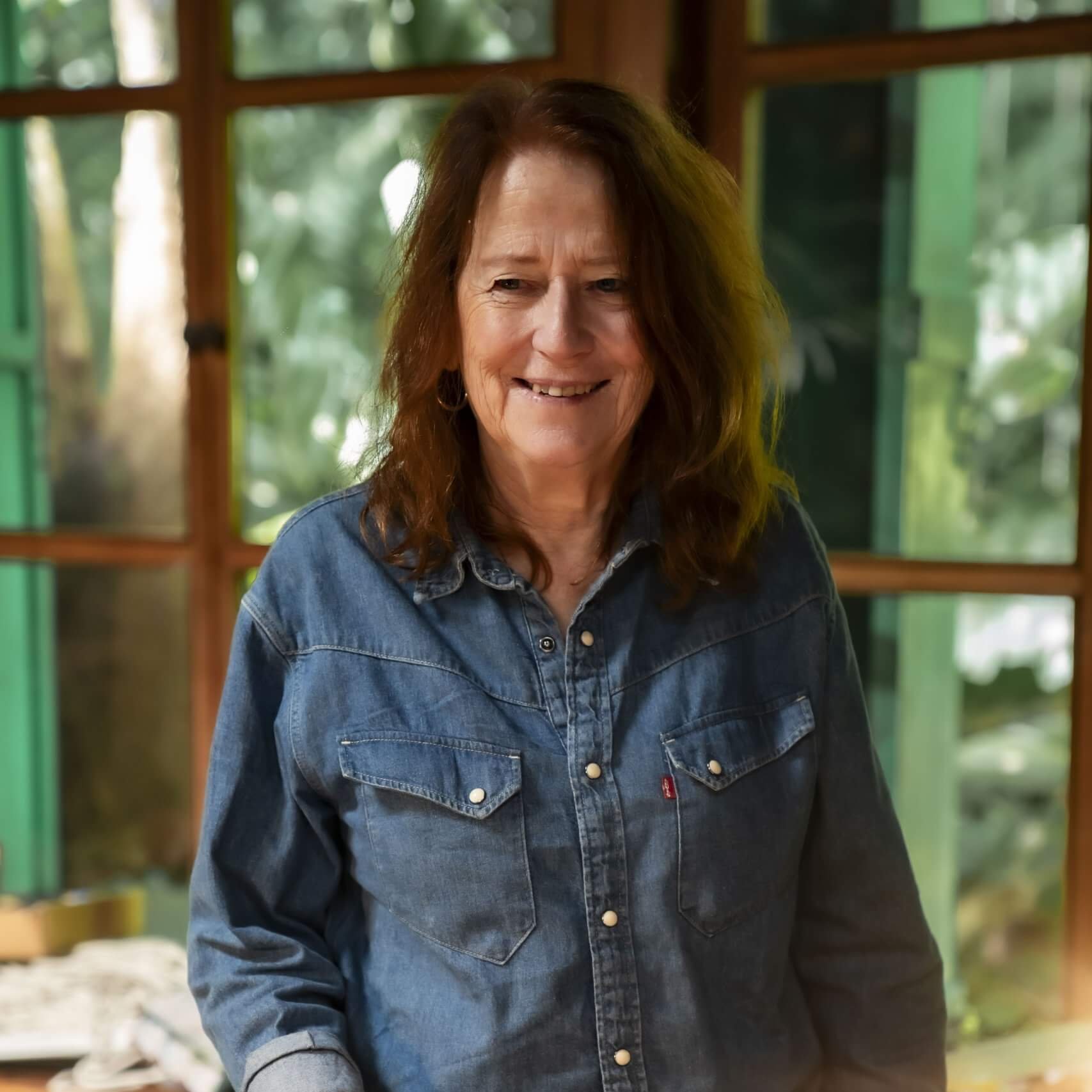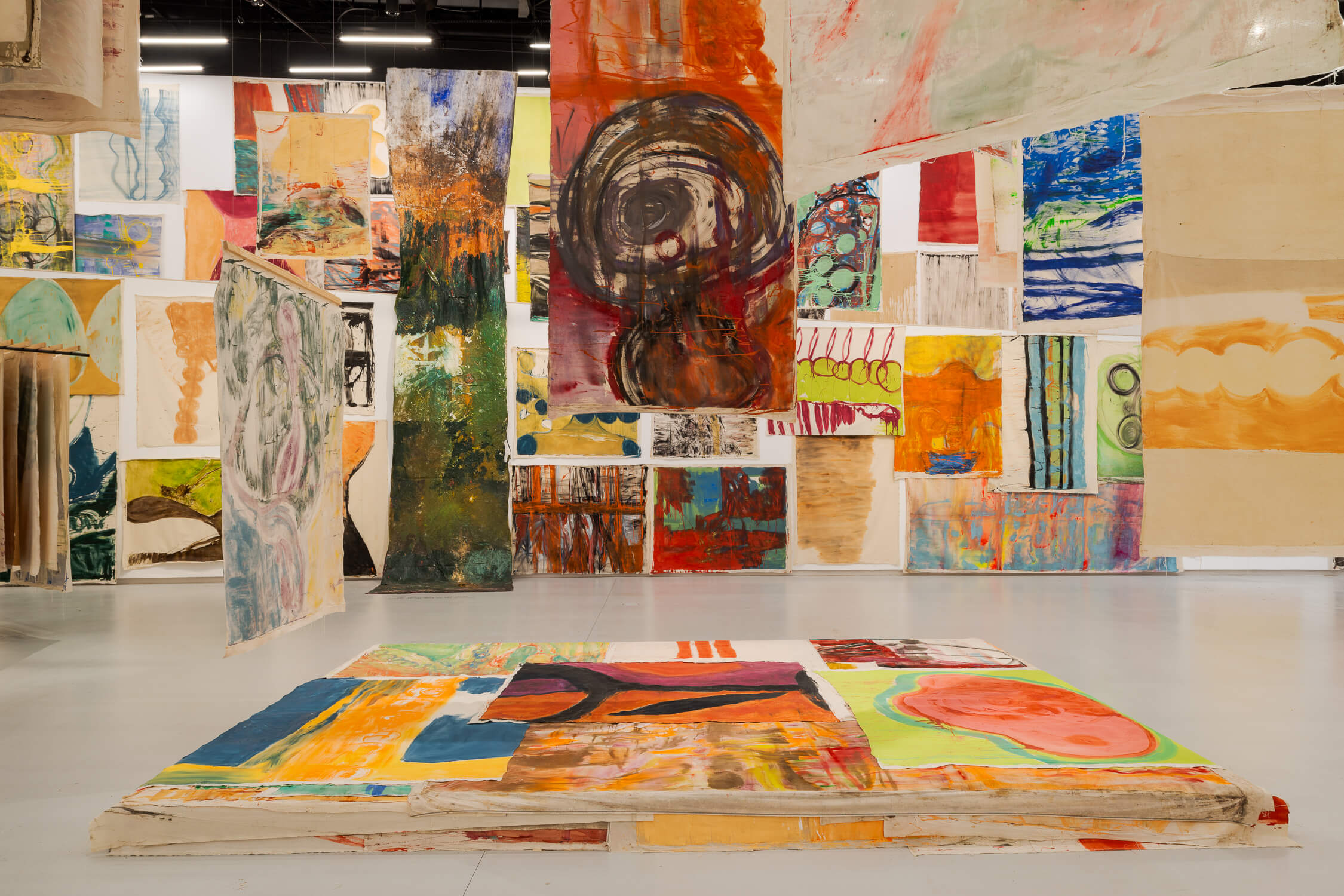SEARCH THE ENTIRE SITE
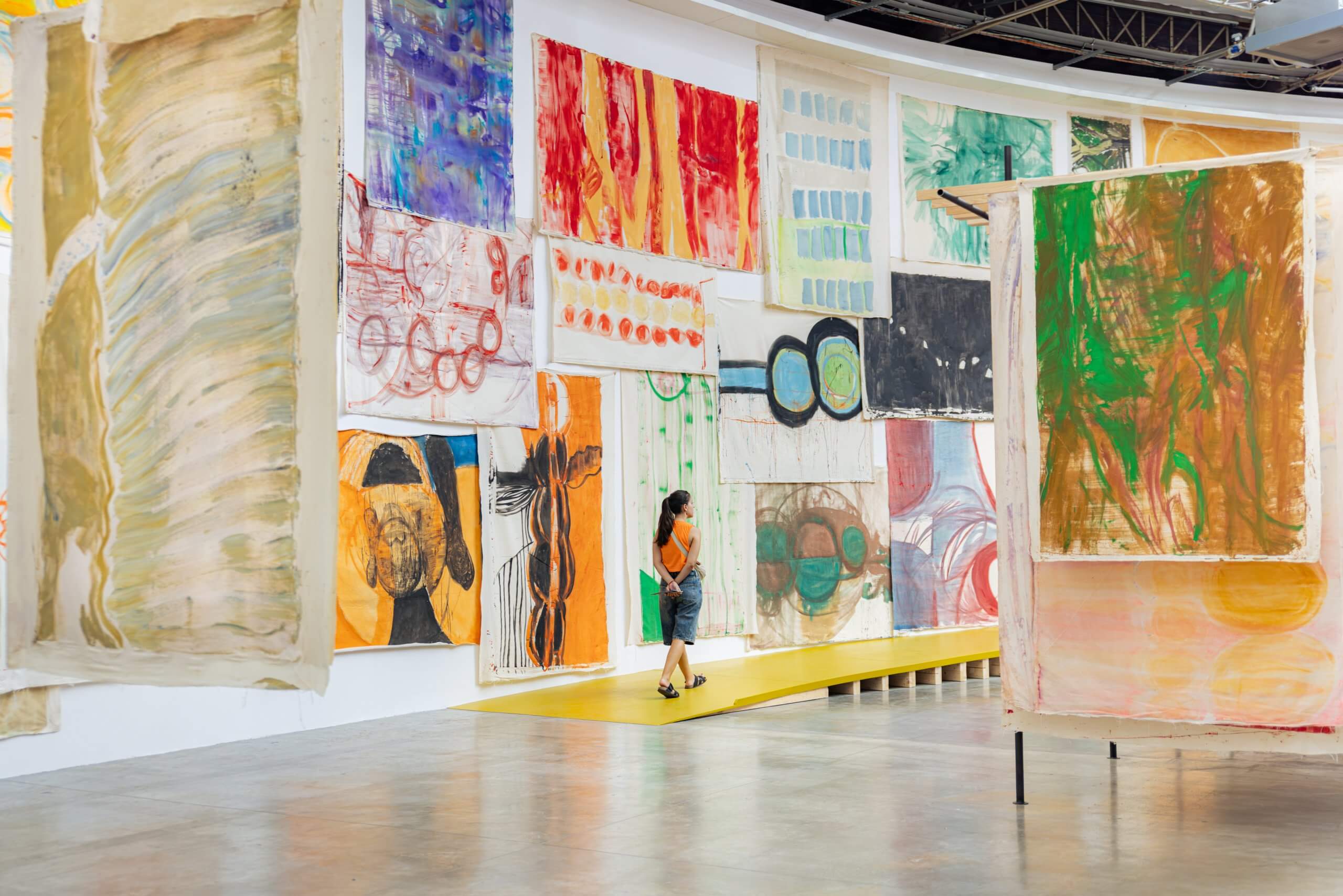
Interview with Vivian Suter & François Piron
We’re at the entrance of the exhibition, from where we can see all the density, nuance and vitality of the works unfolding under the large glass roof, from floor to ceiling. How did you come up with this show?
François Piron: As you can see, the installation is very empirical. We did have a plan, but we didn’t follow it. We also gave a significant degree of freedom to the installation team. We just kept a few rules: it has to be dense, take over the entirety of the walls from top to bottom, and have a lot of contrasts. It’s always good to push the contrasts as much as possible, from dry to liquid, from one colour to another, from the gestural to the geometric. And at the base of the walls, which allow for a very close access to details, we chose works with more material collected on their surfaces. For instance, at the entrance of the show, there is one painting with leaves and mud. It’s very fragile in a way, but as you say Vivian, that’s life. On the next one, you can also see a lot of Vivian’s dogs pawprints since they walked all over it.
So, first the leaves, then the dogs… Were those accidents?
Vivian Suter: The leaves, yes – almost. But I helped a bit. They just fall and since I use fish glue on the canvases, they stick to it. The pawprints, well, they’re really accidental. But I don’t scold my dogs anymore – I just leave them be! And here there’s a piece of cardboard on a canvas: it must have been near me while I was painting, so I kept it.
FP: As you can see as well, we haven’t hung the paintings according to the way they were painted. You can see it with the drips. They’re usually just hung however we felt like hanging them at the moment of the installation. They could be hung in another position in a different exhibition.
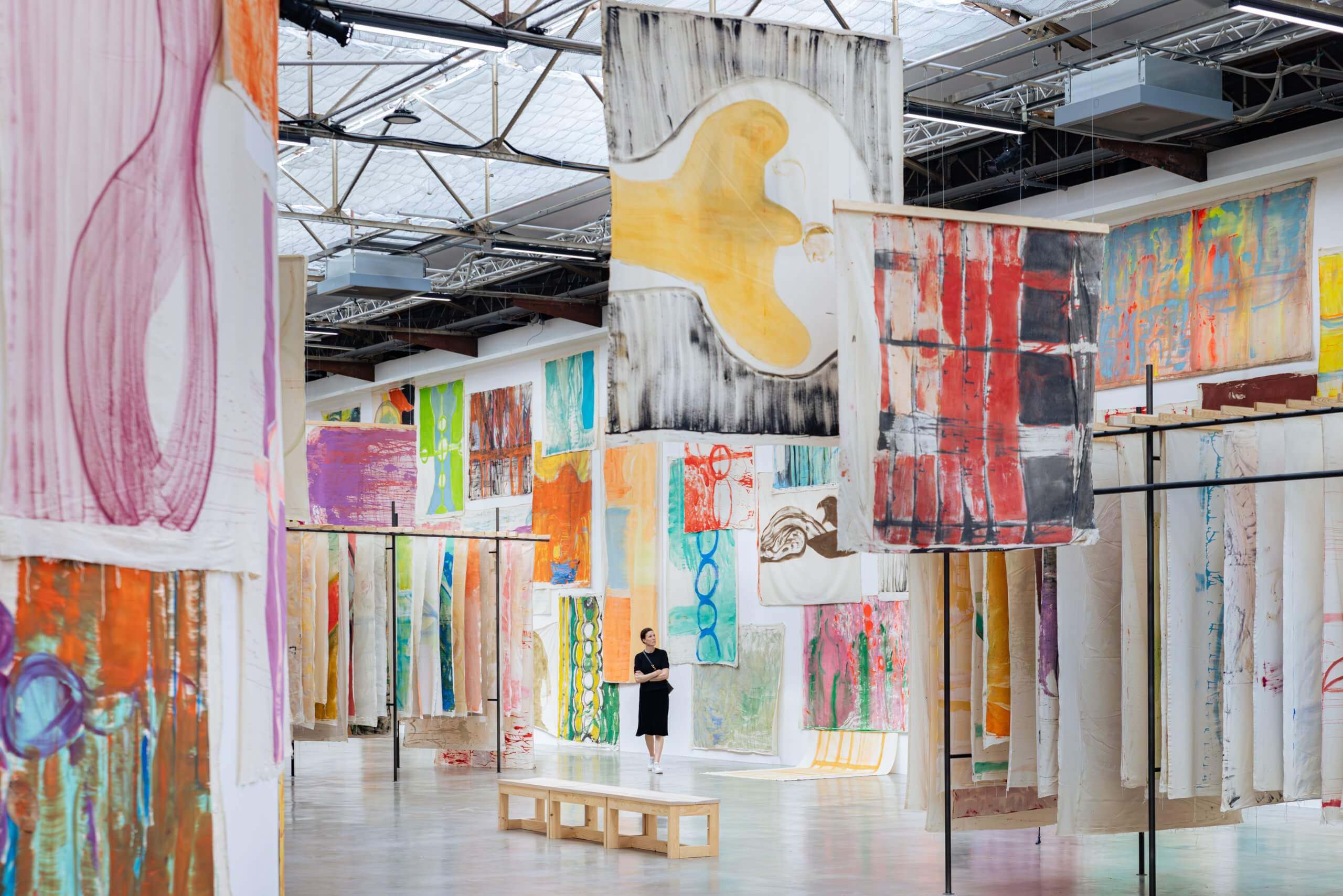
There are almost 500 paintings on display here, and that’s just a fraction of what you’ve created in almost 25 years. How do you preserve your work?
VS: I hang them on racks like in the exhibition. I paint every day, so there are a lot of canvases. When they’re stored like this, you can’t see all of them individually. So I see this also as a kind of sculpture.
Do you remember every painting you make?
VS: Not really. But I recognise most of them when I see them. Some surprise me. And I keep all of them: I don’t destroy or throw away any of them. Because for me, it’s the moment that counts. So I keep them. I may not like all of them later, but they are there.
All your works express a moment, which can be perceived through the energy of the gesture, the effusion of colour and the natural materials that permeate them. But are there different eras we can periodise? For example, how do you choose colors?
VS: You can’t chronologise or periodise them. However, you can sometimes recognise some older paintings. I always choose colours that I have around me, and get the impulse in the moment to start to paint. The environment and nature are my inspiration. That’s why it’s easy for me. I would for example, choose the colour blue because it’s near to hand but also because of a matter of energy in the moment. There is no symbolism in it.
FP: In recent years, it has become impossible to recognise which painting comes earlier or later. And since the paintings have no dates, it’s easy to forget when they were done exactly.
VS: What is important for me is that the exhibition is one whole thing.
FP: Of course, the paintings are all individually important. But it’s also a whole, one that emerges from 25 years of painting.
Your paintings aren’t dated but at the same time they receive the imprint of natural elements from the moment of their creation. How would you describe the link between your practice and memory?
VS: Well, with the paintings, I do remember things about circumstances, things that happened. So I have these memories, but I don’t think having the dates would help me memorise them any better. I also use rainwater in my practice. I think maybe in the future, I don’t know in how many years, we’ll be able to recognise dates and events from elements of the atmosphere. I keep that in mind when I create. So for now, there’s no date, but it could be reconstructed once they have, maybe, a machine to do so.
Some of your paintings are also double-sided. Were they created in two different moments or is it just one moment that goes all around the canvas, on both sides?
VS: It’s one moment, at the same time. Sometimes, the paint seeps through, you know, so I paint on the other side too.
FP: When a painting is done, you don’t come back to it, do you ?
VS: Not really. But sometimes I do, and then I regret it because I have destroyed that moment.
As we are walking into the yellow room, could you tell us more about it ? While the main space is a really dense installation between white walls, this one is like an almost empty space with coloured walls. It’s quite a contrast!
VS: Painting this room in yellow is fun, so I’m happy. The collages deserve to be appreciated differently. When my mother was alive, she always used colored walls in her shows. Her collages are from magazines, like architectural, glossy, fashion, lifestyle magazines that she got from friends. Since she didn’t want to paint anymore because she was in a wheelchair, she started producing collages everyday. She had boxes with cut-out things that she would choose from and draw them together. She already made collages before that, like I have some that she did in Switzerland, but not so many.
FP: We also lived in neighbouring houses in my garden, so I would come to her and look at what she was doing. Although she worked inside, and couldn’t see me painting, it was sometimes really astonishing to notice correspondences between what we were both doing at the same time. Sometimes I would move a little detail while she wasn’t looking, but she would always notice immediately!
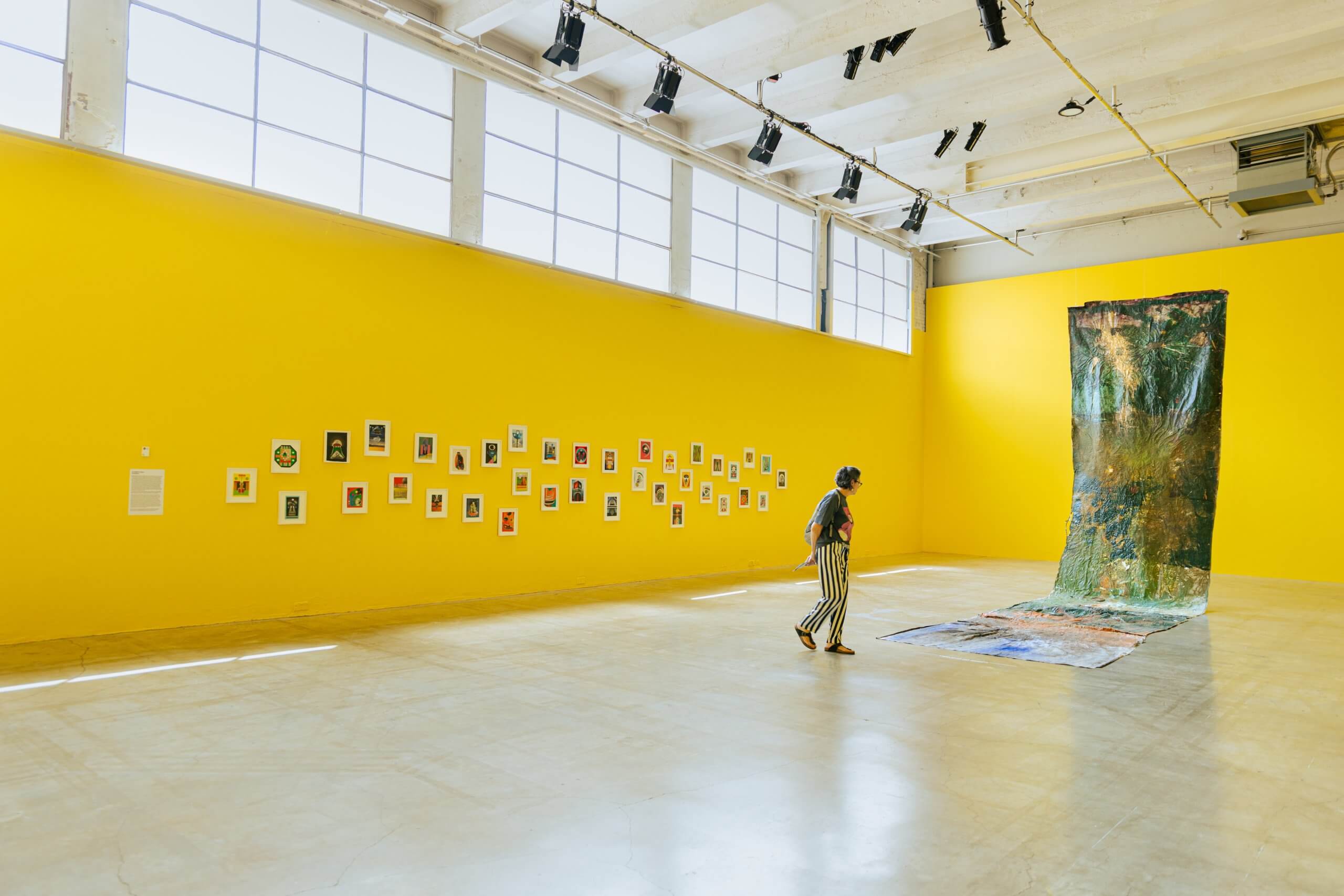
As you said, your main sources of inspiration are the environment and nature. We can also feel it in the general scenography which is really organic. Do you sometimes paint with other people or make portraits of them?
VS: Not really, but I do sometimes paint my dogs, as they are always with me. In one of the canvases here, near the yellow room, you can recognize my dog Bonzo. The show is also called “Disco”, after the name of another of my dogs. I mostly paint nature, like leaves, trees, branches and fruit. And I also like to paint sounds. When I’m outside in my garden, I can hear the sounds from the village: the church, the birds, the dogs…
FP: I think your work is very much about energy, actually. The paintings, whatever the shape or the structure, are gestures. They document impulses of energy, which can have many layers. They are about resonance as well, about sounds that resonate or reverberate.
You said you paint everyday, and you do so outside, in your garden. Do you even paint in the rain?
VS: Yes, I paint even when it’s raining. You can feel it, right? The paint is wet. I really like it, because the canvases are already humid and all wet, it’s a different approach. And it helps me to get inspired…
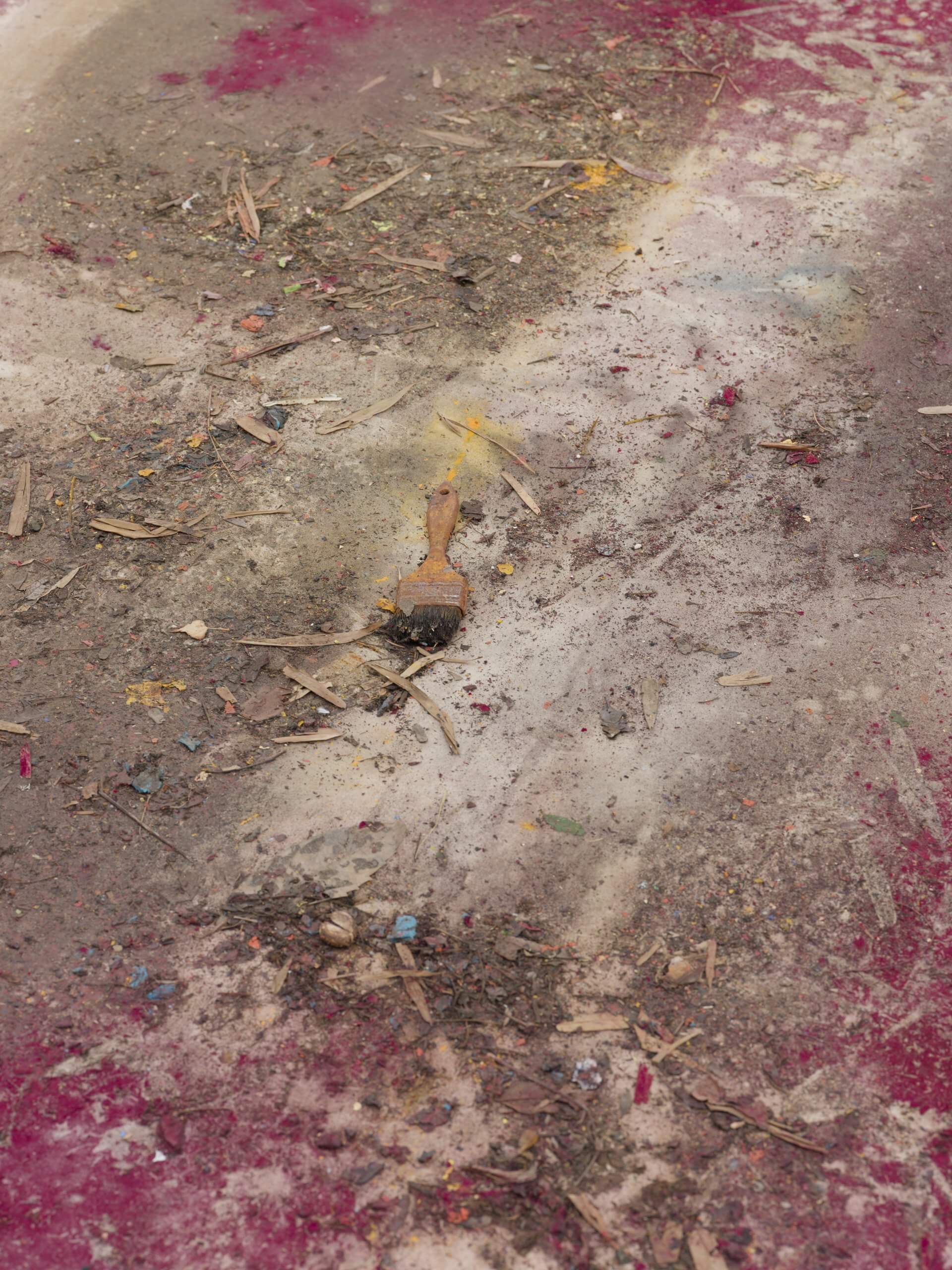
We’ve now reached the end of the exhibition and the end of our stroll together. Here, as in the rest of the exhibition, the large glass roof is open and the works are exposed to natural light, which is quite uncommon for an exhibition. Would you say a few words about this choice and about this last room?
FP: At the end of the show, after the stairs, everything shifts upwards: all the structures are suspended, they don’t stand on the ground. And as in the rest of the show, the paintings are indeed under the glass roof that will be open and with natural light.
VS: The idea, too, is that the paintings will move around in the breeze.
FP: There is also a miniature model of Palais de Tokyo with an early proposal for the scenography and layout. I brought it in a suitcase to Vivian’s house, where we tried out different configurations over the course of three days. You could play the game of finding the differences between the initial proposal in the model and the end result here. We needed to have a sort of basis to be able to know how to prepare the exhibition, to structure it and to start installing. But from day one of the installation, we had a reality check and said to ourselves: “OK, now let’s start all over again.”
